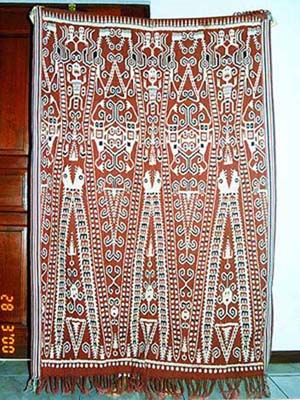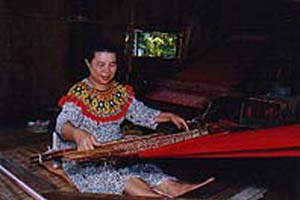|
|
|||||||||||||||||||||||||||||||||||||||||||||
|
|
|||||||||||||||||||||||||||||||||||||||||||||

|
|||||||||||||||||||||||||||||||||||||||||||||
|
OMEGA WEAVING Borneo is rich in natural resources like the climbing rottan, swamp nipah, pandanus palms and bemban reed, the stems and leaves of which are used to make useful items like baskets, mats and hats needed by the indigenous people of Sarawak. As their farms are usually some distances away from their villages and longhouses, these items are useful and necessary for them to transport their crops to their villages. Ceremonial rituals also play a significant part in their spiritual life and this is where the Pua Kumbu (Ceremonial Blanket) comes in.
PUA KUMBU The Pua Kumbu is the famous double-ikat blanket made by Iban women, who are acknowledged to be the finest weavers in all of Borneo. The Pua Kumbu is woven from individually dyed threads on a simple backstrap loom, and a particularly fine piece can take months to produce. The patterns and motifs are derived from traditional animistic beliefs, and include guardian figures, rice spirits, and symbols of the supernatural. Weaving of certain designs requires great spiritual power on the part of the weaver. In the egalitarian Iban society, a woman who wove a superb Pua Kumbu could achieve the same social status as a great warrior. Traditionally, weaving has been a means of evaluating the status of a woman in the native group of Iban community. A woman, who is capable of designing and producing a good blanket, is a woman of fame and renown in her community and beyond. She is regarded as a special person, and it is believed that her knowledge of mixing and mordant is evidence of a mystical relationship with an ancestral weaver. To be able to create and weave a good Pua Kumbu is not only a demonstration of her knowledge and expertise but is also revealing of the character of her soul. OTHER WOVEN ITEMS On the other side of the coin, weaving among the indigenous people also exist in the form of sleeping mats, baskets, place mats and coasters. Traditionally rattan baskets were used for farming purposes - closely woven ones for seed at sowing time, strong but light ones for carrying home the harvest. The black color is achieved by soaking the split rattan in a bath of mud, leaves and roots. The decorative motifs created include ferns, fruits, creepers and shoots, leeches, snakes and birds. Sarawak's native Penan are famous for the mats and baskets woven by their womenfolk. They use the finest rattan, plaited very closely. The most typical are two-colored mats. They create asymmetrical, sometimes picturesque designs, including human and animal figures, in their mats. Webmaster: Functionet Management Services / E-mail: functionet@hotmail.com Copyright © 1996 [Functionet Management Services]. All rights reserved. Last Updated: April 24, 2000. |

|
||||||||||||||||||||||||||||||||||||||||||||

|
|||||||||||||||||||||||||||||||||||||||||||||

|
|||||||||||||||||||||||||||||||||||||||||||||
|
|||||||||||||||||||||||||||||||||||||||||||||
|
|||||||||||||||||||||||||||||||||||||||||||||